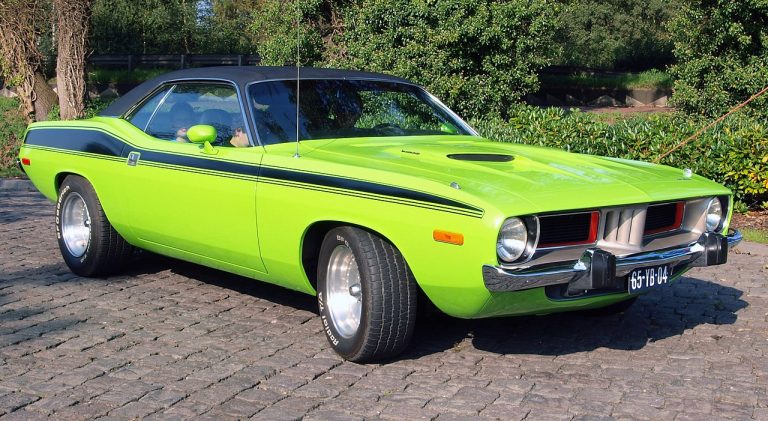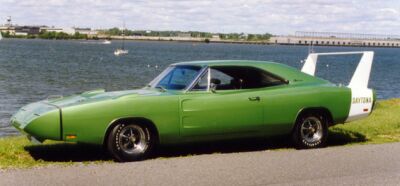Chevrolet Impala SS
Impala SS History
1958-1969
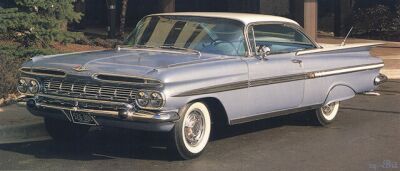
Introduction: The Chevrolet Impala is often credited with starting the muscle car era. Born as Chevrolet’s top of the line model, the Impala quickly became the symbol for performance in the early sixties and introduced Chevrolet’s signature “SS” brand of performance. Although it would later be eclipsed by smaller, lighter automobiles, the Impala still remains the performance car of choice for those that like big cars.
1958 Chevrolet Bel Air Impala

Comments: The Impala began as the top option level on Chevrolet’s Bel Air line. Chevrolet’s 1958 lineup featured one year only styling that sported “curves where before there were lines.” The Impala option added special trim, deluxe interiors, and resulted in the steepest price in the Chevrolet lineup. Performance was important from the beginning as the first Impala could be optioned with up to a 348 V8 putting out 315 bhp. The public’s positive response lead to Chevrolet making the Impala a separate option for the next year.
Production: 2D Hardtop: 43,000 Convertible: Approximately 17,000
Engines: 235.5 I6 145 bhp. 283 V8 185 bhp. 283 V8 230 bhp. 283 V8 250 bhp. 348 V8 250 bhp. 348 V8 280 bhp. 348 V8 315 bhp.
Performance:
1959 Chevrolet Impala
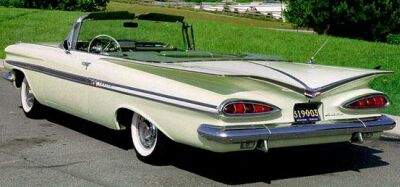
Comments: The Impala became its own model in 1959. As with all 1959 Chevy’s, the new Impalas were longer, lower, wider, and more curvy. They also had the wildest tailfins besides Cadillac. The rear end sported “bat wing” rear fenders, “cat’s eye” taillamps, and a huge decklid. The drivetrain stayed the same, with some increases in horsepower and sales remained good. Of particular interest to enthusiasts were the availability of fuel injected 283 V8’s, although these were rare.
Production: Sport Coupe: 182,520 Convertible: 72,765
Engines: 235.5 I6 145 bhp. 283 V8 170 bhp. 283 V8 185 bhp. 283 V8 230 bhp. 283 (fuel injected) V8 250 bhp. 283 (fuel injected) V8 290 bhp. 348 V8 250 bhp. 348 V8 320 bhp. 348 V8 335 bhp.
1960 Chevrolet Impala
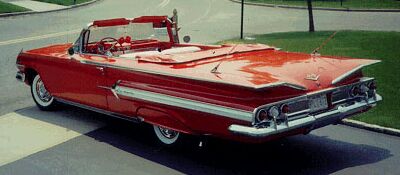
Comments: The Impala was toned down for 1960 and lost some of their distinct styling and fuel injected engines.
Production: Sport Coupe: 204,467 Convertible: 79,903
Engines: 235.5 I6 145 bhp. 283 V8 170 bhp. 283 V8 185 bhp. 283 V8 230 bhp. 348 V8 250 bhp. 348 V8 320 bhp. 348 V8 335 bhp.
1961 Chevrolet Impala SS
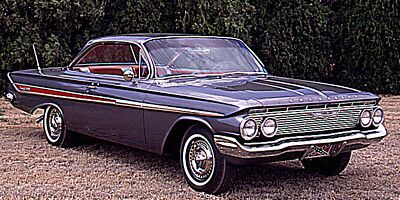
Comments: 1961 would be the year that the first true muscle car was introduced, the Chevrolet Impala SS. This would also be the year that Chevrolet introduced its 409 cubic inch V8, the engine that would launch the Big Three auto manufacturers into the horsepower race that would last well into the 1970s. The 409 was actually a response to Ford’s new 390 cid engine, which was outperforming Chevy’s on the drag strip. Although it put out “only” 360 bhp compared to Ford’s top 375 bhp, those extra 19 cid gave it respect on the street and immortalized in song (“She’s really fine, my 409“).
Chevrolet introduced the Super Sport (SS) option package, which was optional on the 348 and standard with the 409, which would define Chevrolet performance for many years to come. The Super Sport package, a bargain at just $53.80, consisted of special body and interior trim, power steering, power brakes with sintered metallic linings, full wheel covers with a three blade spinner, a passenger grab bar, a console for the floor shift, and a tachometer on the steering column. The 409 engine came only with the four-speed manual transmission and only one factory axle ratio. Lower axle ratios were available from the dealer and owners could see 1/4 mile times in the high 15s, which was pretty impressive in 1961. Unfortunately, the 409 already came with 11.25 compression and a four barrel carburetor, and due to its wedge shaped combustion chambers was not very easy to improve performance further. But no matter. Although only 142 Impala SS 409s were built in 1961 (and most went to good customers that would run them at the local drag strips), the legend was born and the horsepower race was on.
Production: Impala SS: 453 Impala SS w/ 409 V8: 142
Engines: 348 (4 bbl) V8 305 bhp. 348 V8 340 bhp. 348 (3×2 bbl) V8 350 bhp. 409 V8 360 bhp @ 5800 rpm, 409 lb-ft @ 3600 rpm.
Performance: 409/360: 0-60 in 7.8 sec. 1/4 mile in 15.8 sec. @ 94.1 mph.
1962 Chevrolet Impala SS
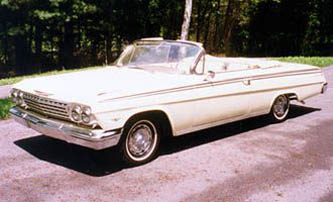
Comments: Chevrolet increased production of the 409 and made it available in all full size Chevy’s – Biscaynes, Bel Airs, and Impalas. The Impala’s were a bit less aerodynamic this year, which made some racers turn to the lighter and slicker Bel Air coupe. The 409 was improved by adding new cylinder heads and a revised camshaft. With the standard 4 bbl carb, the 409 produced 380 bhp. But the real news was the improved top of the line 409 which added a pair of Carter AFB four barrel carbs and a lightweight valve train, and produced an astonishing 409 bhp, or a magical 1 bhp per cid. The 409 legend grew.
Production: Impala SS: Approximately 100,000. Impala SS w/ 409 V8: 15,091
Engines: 283 V8 170 bhp. 283 V8 195 bhp. 327 V8 250 bhp. 327 V8 300 bhp. 409 V8 380 bhp. 409 (2×4 bbl) V8 409 bhp.
Performance:
1963 Chevrolet Impala SS
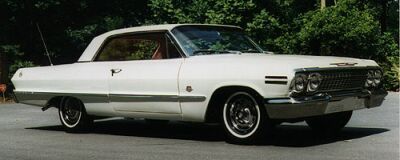
Comments: 1963 saw the Impala SS continue to increase in performance and popularity. With the elimination of the Bel Air coupe, buyers again switched back to Impala SS coupes and convertibles. The 409 was further improved for driveability and a detuned version with 340 bhp was made available with an optional Powerglide automatic transmission. For the serious enthusiasts, Chevrolet offered the 409 with solid lifters and a single four bbl carb good for 400 bhp and a solid lifter 409 with two four barrel carbs good for a whooping 425 bhp. As if that wasn’t enough, Chevrolet introduced a new engine, the Z-11 in mid 1963. This was a 427 cid V8 loosely based on the existing 409 but featured a smaller bore and a longer stroke. It featured angled valves and was nicknamed the “porcupine head motor.” Although it was officially rated at 430 bhp, it easily made close to 500 bhp and was an instant success at the drag strip. Unfortunately, it was only available to factory approved customers through Chevrolet’s RPO (Regular Production Option). It was usually coupled with the optional factory fitted lightweight front end – aluminum panels and bumper. In addition, Chevrolet was preparing another 427 V8, the Daytona “Mystery Motor” to be used at the 1963 Daytona race. However, Chevrolet officially withdrew from racing competition, putting a stop to development of the “Mystery Motor” and after only 55 Z-11 Impalas were built. The 427 would not reappear for another three years, but it would be a direct descendant of the “Mystery Motor” that Chevrolet had killed in 1963.
Production: Impala SS: 153,271
Engines: 283 V8 170 bhp. 283 V8 195 bhp. 327 V8 250 bhp. 327 V8 300 bhp. 409 V8 340 bhp, 430 lb-ft @ 3200 rpm. 409 V8 400 bhp. 409 (2×4 bbl) V8 425 bhp. (Z-11) 427 V8 430 bhp.
Performance: 409/340: 0-60 in 6.6 seconds, 1/4 mile in high 15s.
1964 Chevrolet Impala SS
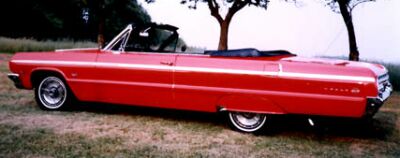
Comments: The Impala SS became its own series for 1964 and continue to feature unique exterior trim and a lavish interior. Available only as a convertible or Sport Coupe, the SS was offered with the same engines as 1963, including the top of the line 409. But the introduction of the Pontiac GTO would steal the Impala SS thunder as buyers began to shift over to smaller, lighter cars that could offer similar performance for less money than the full size car.
Production: Impala SS: 185,325 Impala w/ 409 V8: 8,684
Engines: 283 V8 170 bhp. 283 V8 195 bhp. (L30) 327 V8 250 bhp @ 4400 rpm, 350 lb-ft @ 2800 rpm. (L74) 327 V8 300 bhp @ 5000 rpm, 360 lb-ft @ 3200 rpm. (L33) 409 V8 340 bhp @ 5000 rpm, 430 lb-ft @ 3200 rpm. (L31) 409 V8 400 bhp @ 5800 rpm, 425 lb-ft@ 3600 rpm. (L80) 409 (2×4 bbl) V8 425 bhp @ 6000 rpm, 425 lb-ft @ 4200 rpm
1965 Chevrolet Impala SS
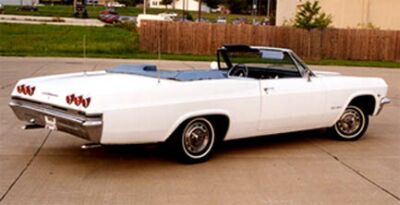
Comments: The Impala was completely redesigned for 1965 and featured a more streamlined look, rather than the boxy look of previous years. In February, the mighty 409 was phased out and was replaced by the Mark IV 396 cid V8, which would power Chevrolets for the rest of the ’60s. The new 396 could be mated to a new automatic transmission, the Turbo Hydra-matic 350. The 396 was a direct descendant of the “Daytona Mystery Engine” The 409s and 396s were available in all Impalas, including four door sedans and station wagons, but the Impala SS continued as a separate series. 1965 also saw the introduction of the Caprice option on the Impala and came standard with a V8.
Production: 239,500
Engines: (L30) 327 V8 250 bhp @ 4400 rpm, 350 lb-ft @ 2800 rpm. (L74) 327 V8 300 bhp @ 5000 rpm, 360 lb-ft @ 3200 rpm. (L35) 396 V8 325 bhp @ 4800 rpm, 410 lb-ft @ 3200 rpm. (L78) 396 V8 425 bhp @ 6400 rpm, 415 lb-ft @ 4000 rpm. (L33) 409 V8 340 bhp @ 5000 rpm, 430 lb-ft @ 3200 rpm. (L31) 409 V8 400 bhp @ 5800 rpm, 425 lb-ft @ 3600 rpm
1966 Chevrolet Impala SS
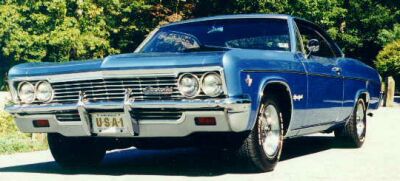
Comments: Due to poor sales, Chevrolet eliminated the SS option on all full size cars except one, the Impala SS 427. The 1969 Impala SS featured new pontoon-bulge fender lines and new “full door glass” which eliminated the vent windows. The 427 engine was carried over from the year before. Only 2,455 copies of the Impala SS 427 were sold, which ensured that this would be the last year of the famed Impala SS. The Impala line would continue, sporting the new 454 cid V8 engine for 1970 and surviving well into the late 1970s. But the Impala would never recapture its performance image and became just a luxury fullsize car. But in retrospect, an impressive 918,000 Impala SS were manufactured, a true testament to its significance.
Production: Impala SS 427: 2,425
Engines: (L36) 427 V8 390 bhp @ 5400 rpm, 460 lb-ft @ 3600 rpm. (LS1) 427 V8 400 bhp @ 5400 rpm, 460 lb-ft @ 3600 rpm. (L72) 427 V8 425 bhp @ 5600 rpm, 460 lb-ft @ 4000 rpm
1967 Chevrolet Impala SS
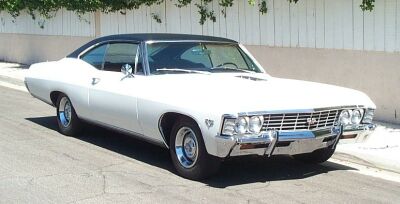
Comments: The Impala SS sales continued to fall as buyers increasingly turned away from fullsize performance. The SS began to look more and more like the standard Impala, with only a black accented lower body sill and bright fender moldings on the SS. The engine choices were reduced down to just a 396 with 325 bhp or a 427 with 385 bhp. The Impala also had a host of new safety and convenience features, including a dual master cylinder brake system, an energy absorbing steering column, and an ignition switch illuminated by the first use of fiber optics technology to appear in a Chevrolet.
Production: Impala SS: 75,600 SS427: 2,124
Engines: (L30) 327 V8 275 bhp @ 4800 rpm, 355 lb-ft @ 4200 rpm. (L35) 396 V8 325 bhp @ 4800 rpm, 410 lb-ft @ 3200 rpm. (L36) 427 V8 390 bhp @ 5200 rpm, 460 lb-ft @ 3600 rpm. (L72) 427 V8 425 bhp @ 5600 rpm, 460 lb-ft @ 4000 rpm
1968 Chevrolet Impala SS
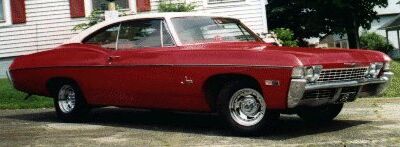
Comments: The Impala SS reverted back to an option for 1968, and was ordered on only 38,210 out of 710,900 Impalas. The SS option was now available on three models, the convertible, the Sport Coupe (hardtop coupe), and the Custom Coupe. Both the 396 and 427 engines continued, despite continued falling sales.
Production: Impala SS: 38,210 SS427: 1,778
Engines: (L30) 327 V8 275 bhp @ 4800 rpm, 355 lb-ft @ 4200 rpm. (L35) 396 V8 325 bhp @ 4800 rpm, 410 lb-ft @ 3200 rpm. (L36) 427 V8 390 bhp @ 5200 rpm, 460 lb-ft @ 3400 rpm. (L72) 427 V8 425 bhp @ 5600 rpm, 460 lb-ft @ 4000 rpm
1969 Chevrolet Impala SS
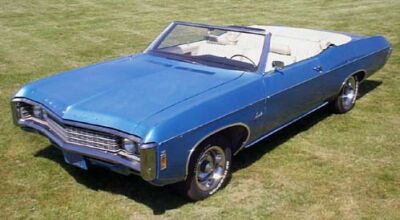
Comments: Due to poor sales, Chevrolet eliminated the SS option on all full size cars except one, the Impala SS 427. The 1969 Impala SS featured new pontoon-bulge fender lines and new “full door glass” which eliminated the vent windows. The 427 engine was carried over from the year before. Only 2,455 copies of the Impala SS 427 were sold, which ensured that this would be the last year of the famed Impala SS. The Impala line would continue, sporting the new 454 cid V8 engine for 1970 and surviving well into the late 1970s. But the Impala would never recapture its performance image and became just a luxury fullsize car. But in retrospect, an impressive 918,000 Impala SS were manufactured, a true testament to its significance.
Production: Impala SS 427: 2,425
Engines: (L36) 427 V8 390 bhp @ 5400 rpm, 460 lb-ft @ 3600 rpm. (LS1) 427 V8 400 bhp @ 5400 rpm, 460 lb-ft @ 3600 rpm. (L72) 427 V8 425 bhp @ 5600 rpm, 460 lb-ft @ 4000 rpm
Impala History
1994-1996
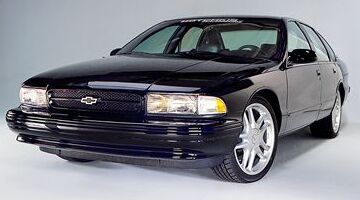
Introduction: To add some flash to its fullsize Caprice, Chevrolet brought back the Impala SS in 1994, 25 years after the last one rolled off the assembly lines in 1969. Sporting a high performance V8 and rear wheel drive, and wrapped in body work to match its performance intentions, the Impala SS was truly a modern muscle car. Though it only lasted three model years, it became an instant cult classic and a fitting tribute to the great Impala’s of the 1960s.
1994 Impala SS

Comments: The Impala SS debuted in 1994 as a high performance model based on the fullsize Caprice platform. It was the first four door sedan to carry the fabled “Impala SS” name (all previous SS models were coupes or convertibles), but Chevrolet made sure that it lived up to its heritage.
As such, it sported rear wheel drive and a commanding presence on the road. The Impala SS was only available in black and featured a body-colored grille, body-color front and rear fascias, rocker moldings, door handles and key locks, taillamp moldings, body-colored raised Impala SS logos along the rear fenders, a unique rear deck-lid spoiler, and Impala emblems on the sail panels and rear deck lid. The interior featured a gray leather interior with deeply contoured front bucket seats and black satin finish on the instrument panel and door trim panels. But the heart of a muscle car is the engine, and Chevrolet didn’t disappoint there. Replacing the Caprice’s rather weak 180 bhp V8 was a new Corvette-derived 5.7 liter LT1 V8 with Sequential Fuel Injection, calibrated to deliver 260 bhp at 5,000 rpm and 330 lb-ft. of torque at 2,400 rpm. The engine was hooked up to the standard GM electronically controlled 4L60-E four speed automatic transmission with a 3.08:1 final-drive ratio and a limited slip differential. Chevrolet also added a special ride and handling suspension derived from the Chevrolet law enforcement package for its Caprices and threw in a quick-ratio power steering unit (12.7:1 vs. the standard 15.3:1 ratio). Tuned front and rear stabilizer bars and de Carbon gas-pressure shocks helped the Impala keep its composure in the twisties while massive 17″ x 8.5″ five-spoke cast-alloy wheels fitted with huge P255/50ZR17 tires kept the Impala SS connected to the road. Standard four-wheel, 12″ diameter ventilated disc brakes and a 4-wheel anti-lock braking system brought the car to a stop if things got out of hand.
Production: About 6,000
Engines: 350 (5.7 liter) V8 260 bhp @ 5000 rpm, 330 lb-ft @ 2400 rpm.
Performance: 0-60 in 7.1 seconds, 1/4 mile in 15.4 seconds @ 91.1 mph.
1995 Impala SS
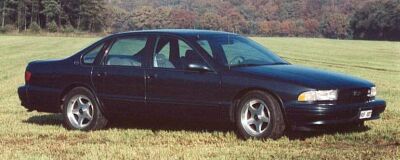
Comments: Changes were minor for 1995. Whereas the previous year had a small plastic insert in the window just forward of the C-pillar, in 1995 this curve was stamped into the body panels. Impalas could now be ordered in two more colors: Dark Cherry metallic (a dark purple), and Dark Green-Gray Metallic. Also, the mirrors moved from being door mounted to being mounted on the window frame and could now foldaway.
Production: 18,649 – Black: 7,134, Dark Cherry: 9,858, Gray Green: 4,442.
Engines: 350 (5.7 liter) V8 260 bhp @ 5000 rpm, 330 lb-ft @ 2400 rpm.
Performance: 0-60 in 7.1 seconds, 1/4 mile in 15.4 seconds @ 91.1 mph.
1996 Impala SS
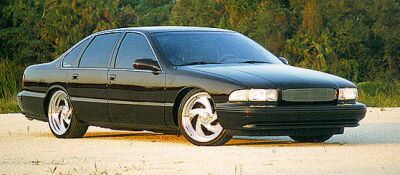
Comments: Changes were minor for 1996, the last year of the Impala SS. The shifter was now mounted on the console and the dash sported an analog gauge cluster. The fuel pressure and voltage gauges were dropped, but a tachometer and analog speedometer was added. Production of the Impala SS actually lasted until December 13, 1996 (well into the 1997 model year), but all Impala SS’s built were labeled as 1996 models.
Production: 41,941 – Black: 19,085, Dark Cherry: 12,180, Gray Green: 10,676.
Engines: 350 (5.7 liter) V8 260 bhp @ 5000 rpm, 330 lb-ft @ 2400 rpm.
Performance: 0-60 in 7.1 seconds, 1/4 mile in 15.4 seconds @ 91.1 mph.


